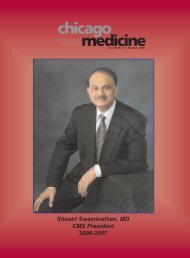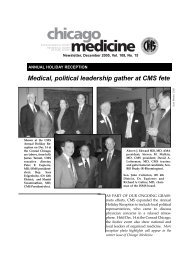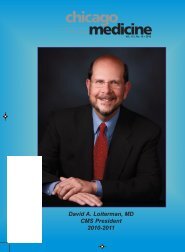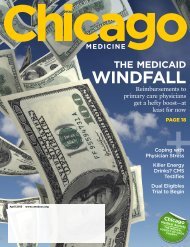Summer 2003 - Chicago Medical Society
Summer 2003 - Chicago Medical Society
Summer 2003 - Chicago Medical Society
Create successful ePaper yourself
Turn your PDF publications into a flip-book with our unique Google optimized e-Paper software.
The malpractice insurance crisisWhat you can do for your practice: Part IBy Christopher R. Jarvis, MBA,and David B. Mandell, JD, MBADoctors from all specialties throughout thecountry are looking for ways to reducetheir malpractice premiums or to find alternativesto their traditional carriers. The questionon their minds, and perhaps on yours as well,is the following: What can you--in your practice--do in response to this malpractice insurance crisis?In this first part of a two-part article, we outline thefirst of three strategies every physician should consider.Make asset protection a priorityRegardless of the state of the malpractice insurancemarket, physicians should always see assetprotection as an important part of their businessand personal financial plan. When we use theterm "asset protection," we mean shielding the assetsof the practice and personal assets from all potentiallawsuits, including malpractice claims.While this has certainly been a priority over thelast decade, at no time has it been more importantthan now. Because premiums have become so expensive,many physicians are considering reducingtheir coverage from traditional limits to lesserlimits. While this may make sense, it is only partof the equation. If you decide to reduce your malpracticeinsurance coverage, this goes hand inhand with implementing an asset protection plan--to protect all of your practice and family wealth.An ideal solution is one that not only reducesyour cost of malpractice insurance, but also providesthe same level of protection for your assets.It makes no sense to reduce coverage limits becausepremiums are expensive and then leaveyour practice's and personal assets exposed to lawsuitsand creditors. That is why asset protection isso important.While an in-depth discussion of the tools andstrategies that asset protection professionals use isbeyond the scope of this article, we will list a numberof tactics here. However, as with insuranceplanning, these strategies and tools must be implementedbefore there is a problem. That is why onemust engage in asset protection planning as earlyas possible.Potential asset protection tactics• Shield the practice's most valuable asset--its accountsreceivable (AR)--through a leveraging orfactoring strategy. Often, this can create significantlymore after-tax retirement wealth, in additionto protecting the AR from medical malpracticeclaims. Your options:• Take a loan against the AR and invest the loanproceeds in an asset that grows tax beneficiallyand is asset-protected. Often this can be achievedby having the practice and the physicians co-investin a limited liability company (LLC). Dependingon how the LLC operating agreement is drafted,significant tax benefits can be enjoyed--givingphysicians the opportunity to build retirementwealth beyond their pension, if the loan terms canbe negotiated to a reasonable level. The AR isshielded because of the lender's security interest inthe receivables.• Sell the AR to a particular type of factoring company.Unlike the "typical" factoring firm thatmakes money on buying your AR on the cheap,these firms offer a pass-through type of arrangementwhere physicians can set the purchase discountat whatever they want, within reasonableparameters. The AR is shielded because of the factoringcompany's ownership of the receivables.14 <strong>Chicago</strong> MedicineVol. 106, No. 11










